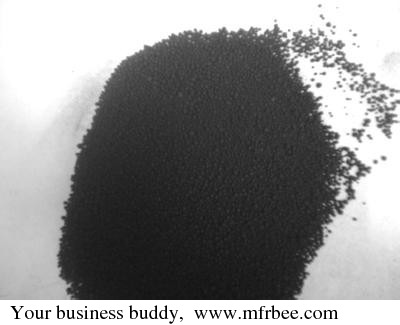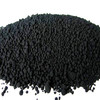Selection & Purchase of Carbon Black
Specifications
Selections of carbon black can be decided according to following technical index of carbon black successively: PH Value, adsorption, blackness/ tinting strength, moisture, residue on sieve, disperse particle size/easy dispersibility��PAH(polycyclic aromatic hydrocarbon)��batch chromatism.
1. PH Value
Experimental Instrument: PH meter, industrial balance, analytical balance, electric hot plate
Experimental method: GB/T 3780.7—2006
PH Value of carbon black corresponds to the manufacturing technique of products, varying from 2-10. It reflects the oxygen content during incomplete combustion process or the thermal cracking. As the producer, PH value hardly varies, which can be checked through type inspection. As far as users are concerned, it should be known how the resin, menstruum, dispersing agent in formulas adapt to the acid-base property of carbon black. Different formulas result in big disparity of dispersity, stability and blackness and this is the first problem to notice during the application of carbon black.
Experimental Instrument: Micro burette, analytical balance
Experimental method: GB/T 3780.2—2007
Adsorption reflects the height of structure of carbon black. In production process reaction temperature, reaction time and dosage of additives decide the the primary particle size and aggregate structure of carbon black. As a critical index in carbon black application, adsorption directly affects the viscosity, pig skin, and stability of materials in liquid formulas(such as paint, printing ink, mill base), as well as the degree of dispersion in formulas of rubber and plastic. Generally speaking, we suggest carbon black with high adsorption in rubber and plastic formulas, but low adsorption in liquid formulas.
3. Blackness/tinting strength
Experimental Instrument: plain grinding machine, analytical balance, blackness instrument Tint test 527
Experimental method: GB/T 7048—2003/ GB/T 3780.6—2007
The analytical method of blackness/tinting strength is actually the criterion of blackness in printing ink application for example, which uses No.4 linseed oil as medium and plain grinding machine for dispersing. It can basically refer to printing ink application, while varying in plastic application due to the dispersion. In this method, manufacturers can expediently control repeatability of products, namely equal quality between batches. To a large extent, blackness is affected by the degree of dispersion of carbon black in medium, thus, manufacturers should have a good knowledge of blackness, and at the same time, choose the type and relevant blackness of carbon black through sample formula experiments. What’s more, blackness of medium-low pigment carbon black is proportional to its tinting strength, that’s to say, the higher the high-pigment blackness is, the smaller the tinting strength will be.Pigment carbon black
4. Moisture
Experimental Instrument: Analytical balance, drying oven
Experimental method: GB/T 3780.8—2008
Although the structure of carbon black is stable and the guarantee period is unlimited, the superficial area of carbon black products is large, making them easy to absorb moisture in air. Generally speaking, low-structure carbon black absorbs moisture slowly, with water content rising from 0.5% to 2.0% as the storage time increased; high-structure carbon black absorbs moisture fast, with water content rising from 0.8% to 5.0%. This feature does no harm to the water application system, whereas causes great disadvantage to organic anhydrous system, leading to the difficulty in grinding, bloating, bubble, and even the scrap of mill base. Thus, customers of organic anhydrous system should propose requirements of guarantee or packaging to the carbon black supplier, in order to ensure the application performance of products
5. Residue on sieve.
Experimental Instrument: Analytical balance, Sieve residue analysis equipment
Experimental method: GB/T 3780.12—2007
As an important index in carbon black application, residue on sieve is easy to stoppage the strainer, needing washing repeatedly; it is also apt to damage the roller surface of three-roller machine, and produce superficial burr or bubbles in plastic and plastic cement production. Residue on sieve is micro particle impurities in carbon black production, mainly including the following cases, metal ion: 20-30ppm, iron rust: 10-50000ppm, hard carbon: 30-3000 ppm, refractory matter: 10-30 ppm. In general, the content of residue on sieve is 10-500 ppm. Residue on sieve of ovenprocess carbon black mainly consists of hard carbon, while that of gas mixing process is iron rust. Customers should choose low sieve residue carbon black according to the quality requirements of products.
6. Dispersed particle size & dispersibility
Experimental Instrument: Melvin MS2000 laser particle size instrument, deft hand
Experimental method: Ultrasonic power 12 end displacement, Speed of 250 r/s, dispersing agent: water
Melvin MS2000 laser particle size instrument can analyze the original particle size and the particle size after 10s’ dispersion of carbon black. The original particle size and dispersibility can be made out through correlation data between carbon black, and this has great guiding significance for customers to choose products. Although all kinds of carbon black can meet the requirements of pigment application (1-20 um) through dispersing equipments, great difference between equipment performance sometimes makes requests for dispersed particle size and the dispersibility. Generally speaking, simple dispersing equipments need to use powdery or easy dispersing products.
Moreover, deft hand can test the dispersing fineness of carbon black under the same process condition, and compare the dispersibility of different products.
7. PAH(polycyclic aromatic hydrocarbon)
Experimental Instrument: GC-MS gas chromatography-mass spectrometer
Experimental method: Use GC-MS to analyze after solvent extraction
Carbon black products are by oil that contains PAH after going through incomplete combustion or splitting decomposition, infinitesimal PAH remaining in the production process. Down-stream products are usually divided into edible, contactable and generally uncontactable, asking suppliers to provide related PAH control standard ofcarbon black, in order to meet particular requirements of down-stream customers.
8. Product batch chromatic aberration
Experimental Instrument: Plain grinding instrument, color-exhibiting instrument
Experimental method: Grind into pulp with plain grinding instrument, made into paper pattern with color-exhibiting instrument, measure chromatic aberration with colorimeter
The batch chromatic aberration����E�� of pigment products provided by foreign pigment suppliers is usually controlled under 1. By testing domestic and overseas carbon black products, it’s known that: if blackness control varies between ±1, chromatic aberration����E��of this carbon black can be Less than or equal to 1, which suggests that only when the blackness is controlled between ±1, can carbon black products reach the international standard of pigment chromatic aberration control. This poses critical requirements for the control of carbon black production process, especially the production of acidity carbon black. Thus, customers must make requests of stable blackness to the suppliers.
- Country: China (Mainland)
- Business Type: Manufacturer
- Market: Asia,Europe,Oceania
- Founded Year: 2004
- Address: Xiweizi Village, Qicun Town, Shizhong District, Zaozhuang City, 277100, Shandong Province, P.R.China
- Contact: Mary Chen










